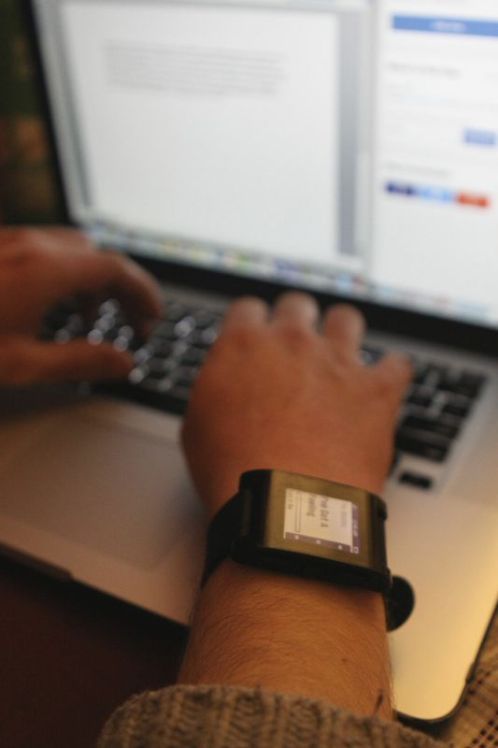
With the Apple Watch, technology takes over the connection between people. Samuel Joseph/The Ram
By Michael Charboneau
_____________________________________________
I swear I felt it. Something buzzed in my pocket, and I instinctively reached for my phone. However, the screen was blank: no text, no missed call and not even a Facebook notification. Phantom limb syndrome happens in amputees, who sense their lost limb as if it were still present. Today, people experience phantom phone syndrome: our phones and other devices have become our phantom fifth limbs. With its new watch, however, Apple is on the verge of forever blurring the line between our physical bodies and the technological limbs that have become attached to us.
Compared to our four flesh-and-blood appendages, the Apple Watch is tiny, sleek and startlingly powerful. According to Apple’s website, users can receive calls, send texts, handle emails and even make payments all from their wrists. The watch can distinguish between a tap and a more forceful touch on the screen, and it communicates with its user through audio responses and vibrations. It tracks the user’s heartbeat and allows him or her to send a “tap” to another person with a watch—essentially a gentle nudge on the wrist. For a device made of metal and glass, Apple’s latest invention maintains a very close relationship with flesh. As TIME’s Nicholas Carr wrote in an article about the product, “It puts our whole bodies online.”
Carr’s statement is no exaggeration. Although still in its infancy, wearable technology like the Apple Watch will profoundly alter the way we communicate with each other. Very soon, we will begin broadcasting our bodies rather than just our thoughts. Carr stated that Apple’s entrance into wearable technology marks a turning point for a medium that has seen little popularity outside of exercise apps, such as Nike+ and its accompanying Fuel Band. Judging from the positive reviews expressed thus far, he wrote that the watch “will be the first wearable to overcome the resistance that has dogged the category.”
The Apple Watch marks the path through which we will shift to broadcasting our bodies wholesale. Devices like the watch could have important medical applications. Doctors could use wearables to track a patient’s recovery after surgery and receive notifications if his or her condition worsens. Carr stated that some major healthcare systems have already seen “some success” in using exercise tracking apps in their regimens. The possibilities stretch beyond just hospitals, however. People with aging parents might gain peace of mind knowing they can be alerted if an elderly loved one falls ill.
Wearable tech’s union with our bodies will also give us unprecedented knowledge about ourselves. The calories we consume, the amount of sleep we get and other bodily minute would suddenly become quantifiable and available right at our wrists. Knowing this information and sharing it with others creates a whole new way to interact and represent ourselves through media. Imagine not only reading your friends’ Facebook statuses and looking at their pictures, but also knowing how much they have had to eat that day.
Not everyone shares this view of the future. Dr. Paul Levinson, a professor in Fordham’s department of communication and media studies and an author of several books on media and technology, sees the Apple Watch as a relatively minor innovation.
“I don’t think that the Apple Watch is that much of a big step ahead of what the iPhone itself does,” he said.
Calling the iPhone “revolutionary,” he sees the watch as merely a way of increasing the convenience of using a smartphone.
“Wearable tech will just keep us even more connected than we are now,” he said, “and it will allow us to communicate faster.”
All technologies have unexpected effects, and devices like the Apple Watch are about much more than simply talking or texting. Even Levinson admits that wearable technology holds a powerful appeal, and he envisions a day in which wearable tech becomes “almost a permanent part of us.”
The effects of the Apple Watch and similar wearable technologies will be immense. Social media outlets such as Snapchat have already created completely new ways of communicating with others, and wearable devices are poised to do the same. In the future, communication will incorporate our bodies in ways that pictures and paragraphs cannot. The Apple Watch is now a blank canvas, but app developers will soon find new and innovative ways to take advantage of its features. When they do, our relationships with technology and with other people will never be the same.
__________
Michael Charboneau is the Web Editor for The Fordham Ram.
